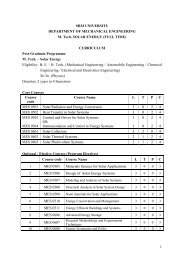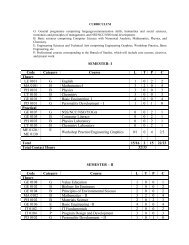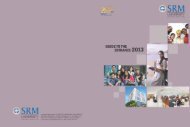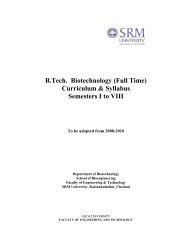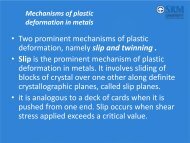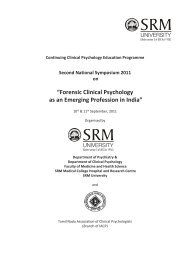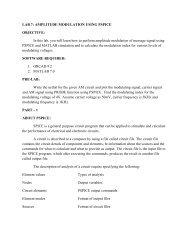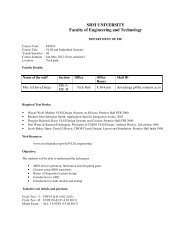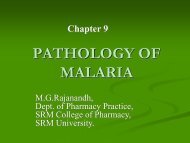LIMIT TESTS 1. LIMIT TEST FOR CHLORIDES Apparatus Required ...
LIMIT TESTS 1. LIMIT TEST FOR CHLORIDES Apparatus Required ...
LIMIT TESTS 1. LIMIT TEST FOR CHLORIDES Apparatus Required ...
You also want an ePaper? Increase the reach of your titles
YUMPU automatically turns print PDFs into web optimized ePapers that Google loves.
<strong>LIMIT</strong> <strong><strong>TEST</strong>S</strong><br />
<strong>1.</strong> <strong>LIMIT</strong> <strong>TEST</strong> <strong>FOR</strong> <strong>CHLORIDES</strong><br />
<strong>Apparatus</strong> <strong>Required</strong><br />
Nessler cylinders<br />
Glass rod<br />
Stand<br />
Chemicals <strong>Required</strong><br />
Dilute Nitric acid (10%)<br />
Silver nitrate (5%)<br />
Sodium chloride<br />
Principle<br />
It is based upon the chemical reaction between silver nitrate and<br />
soluble chlorides in presence of dilute nitric acid to give opalescence of silver<br />
chloride. If the Opalescence produced is compared with the standard solution.<br />
If the opalescence in the sample is less than the standard, it passes the test. If<br />
it is more than the standard, it fails the test.<br />
dil HNO 3<br />
Cl - +AgNO 3 AgCl + No 3<br />
Procedure<br />
Take two 50 ml Nessler Cylinders. Label one as “Test” and the other as<br />
‘Standard’.<br />
Test<br />
Standard<br />
Dissolve the specified quantity of the Place 1ml of 0.05845% w/v solution of<br />
substance in distilled water and transfer NaCl and transfer to Nessler cylinder.<br />
Add 10 ml of dil. Add 10ml of dil. Add 10ml of dil.HNO 3 . Dilute to 50ml<br />
HNO 3. Dilute to 50ml with water and with water and add 1 ml of silver nitrate<br />
add 1 ml of silver nitrate solution. Stir solution. Stir immediately with a glass<br />
immediately with glass rod and allow rod and allow to stand for 5 minutes.<br />
to stand for 5 minutes.
<strong>LIMIT</strong> <strong>TEST</strong> <strong>FOR</strong> SULPHATES<br />
<strong>Apparatus</strong> <strong>Required</strong><br />
Nessler cylinders<br />
Glass rod<br />
Stand<br />
Chemicals <strong>Required</strong><br />
<strong>1.</strong>Dilute Hydrochloric acid<br />
2.Barium sulphate reagent.<br />
Mix 15ml of 0.5m BaCl 2 ,55ml of water and 20ml of sulphate free alcohol and<br />
add 5 ml of 0.0181% w/v potassium sulphate. Dilute to 10ml with water and mix.<br />
0.5m BaCl 2 Barium chloride in 1000 ml of water.<br />
Principle<br />
It is based upon the chemical reaction between Barium chloride and soluble<br />
sulphate in presence of dilute Hydrochloric acid . The turbidity produced is<br />
compared with the standard solution. Barium sulphate reagent contains barium chloride,<br />
sulphate – free alcohol and small quantity of potassium sulphate. The inclusion of the<br />
small quantity of potassium sulphate in the reagent increase the sensitivity of the test.<br />
Alcohol prevents super saturation and more uniform turbidity develops. If the turbidity<br />
produced in the test is more intense than the standard turbidity it fails the test .<br />
otherwise, it passes the test.<br />
dil Hcl<br />
SO 2- 4 + BaCl 2 BaCl 2 + 2Cl -<br />
Procedure<br />
Take two 50 ml Nessler Cylinders. Label one as “Test” and the other as<br />
‘Standard’.<br />
Test<br />
Standard<br />
Dissolve the sample in distilled water Place 1ml of 0.1089% w/v solution of<br />
and transfer to a Nessler cylinder. Add 2 potassium sulphate and 2 ml of dil. HCI<br />
ml of dilute Hydrochloride acid. Dilute to in a Nessler’s cylinder. Dilute to 45ml<br />
45 ml with water and add 5ml of Barium with water and add 5ml of Barium
sulphate reagent. Stir immediately with a sulphate reagent. Stir immediately with a<br />
glass rod and allow to stand for 5 glass rod and allow to stand for 5<br />
minutes.<br />
minutes.<br />
<strong>LIMIT</strong> <strong>TEST</strong> <strong>FOR</strong> IRON<br />
<strong>Apparatus</strong> <strong>Required</strong><br />
Nessler cylinders<br />
Glass rod<br />
Stand<br />
Chemicals <strong>Required</strong><br />
<strong>1.</strong> Standard Iron Solution :0.1726 gm of ferric ammonium Sulphate and dissolve<br />
in 10ml of 0.1 N H 2 SO 4 and sufficient water to produce 1000 ml.<br />
2. 0.1 N H 2 SO 4 :4.904 gm in 1000ml of water.<br />
3. 20% Iron free citric acid.<br />
4. Thioglycollic acid<br />
5. Ammonia solution.<br />
Principle<br />
The test depends upon the reaction between ferrous iron and<br />
thioglycollic acid in the presence of ammonia When a pale pink to deep<br />
reddish purple colour is produced. Ferric iron is reduced to ferrous iron by<br />
the thioglycollic acid and the compound produced is ferrous thioglycollate .<br />
Citric acid forms a soluble complex with iron and prevents its precipitation<br />
by ammonia as ferrous hydroxide. Ferrous thioglycollate is colourless in neutral or<br />
acid solutions. The colour develops only in the presence of alkali. It is stable in the<br />
absence of air but fades when exposed to air due to oxidation to the ferric compound.<br />
Therefore the colours should be compared immediately after the time allowed for full<br />
development of colours is over.
2Fe ++ + + 2CH 2 SH.COOH 2Fe ++ + + S.CH 2 .COOH<br />
Ferric Iron Thioglycollic acid Ferrous Iron<br />
S.CH 2 .COO +2H +<br />
2Fe ++ + + 2CH 2 SH.COOH<br />
CH 2 SH<br />
OCO<br />
Fe +2H +<br />
COO HS- CH 2<br />
Ferrous thioglycollate<br />
(Coordination compound )<br />
Procedure<br />
Take two 50ml Nessler cylinders. Label one as ‘Test’ and the others as<br />
‘standard’.<br />
Test<br />
Standard<br />
Dissolve a specified quantity of the Dilute 2 ml of standard Iron solution with<br />
substance in 20 ml of water and transfer 20ml of water in a Nessler cylinder.<br />
to Nessler cylinder. Add 2 ml of a 20% Add 2 ml of a 20% w/v solution of iron –<br />
w/v solution of iron –free citric acid and free citric acid and 0.1 ml of thioglycollic<br />
0.1 ml of thioglycollic acid and mix. acid and mix. Make alkaline with iron-<br />
Make alkaline with iron-free ammonia free ammonia solution. Dilute to 50ml<br />
solution. Dilute to 50ml with water and with water and allow to stand for 5<br />
and allow to stand for 5 minutes. minutes.
<strong>LIMIT</strong> <strong>TEST</strong> <strong>FOR</strong> HEAVY METALS<br />
<strong>Apparatus</strong> <strong>Required</strong><br />
Nessler cylinders<br />
Glass rod<br />
Stand<br />
Chemicals <strong>Required</strong><br />
(i) Dilute CH 3 .COOH(10% v/v)<br />
(ii) Dilute Ammonia (10% v/v)<br />
(iii) Hydrogen sulphide solution (Saturated of H 2 S).<br />
(iv) Standard lead solution<br />
10ml of the lead nitrate stock solution diluted to 100 ml with water.(20 ppm of<br />
lead).<br />
Lead nitrate stock solution<br />
Dissolve 0.1598 gm of lead nitrate in 100 ml of water , add 1 ml of con.<br />
HNO 3 and dilute to 1000 ml with water.<br />
Principle<br />
It is based on the reaction between the solution Heavy metals and a<br />
saturated solution of Hydrogen sulphides. In acidic media, it produces reddish /<br />
black colour with Hydrogen sulphide which is compared with standard lead<br />
nitrate solution.<br />
Pb+ H 2 S Pbs + H 2<br />
Procedure<br />
Take two 50 ml Nessler Cylinders. Label one as “Test” and the other as<br />
‘Standard’.<br />
Test<br />
Standard<br />
Place 25ml of the solution and adjust 2 ml of standard lead solution is taken<br />
the pH 3-4 by using dilute acetic in a Nessler cylinders and dilute 25 ml<br />
acid or dilute ammonia. Dilute to 35ml with water. Adjust the pH 3-4 by<br />
with water and mix. Add 10ml of freshly using dilute acetic acid or dilute<br />
prepared H2S solution. Dilute to 50ml ammonia. Dilute to 35ml with water and<br />
with water. Mix well and allow to stand mix. Add 10ml of freshly H 2 S
for five minutes.<br />
solution. Dilute to 50ml with water. Mix<br />
and allow to stand for five minutes.<br />
PREPARED BY<br />
B.KIRUTHIGA<br />
LECTURER<br />
DEPT OF PHARMACEUTICAL CHEMISTRY<br />
2.




